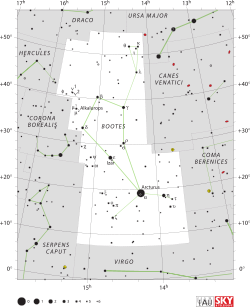Zeta Boötis
| Observation data Epoch J2000 Equinox J2000 |
|
|---|---|
| Constellation | Boötes |
| Right ascension | 14h 41m 08.95158s |
| Declination | +13° 43′ 41.8967″ |
| Apparent magnitude (V) | 3.78 (4.43/4.83) |
| Characteristics | |
| Spectral type | A2III / A2III |
| U−B color index | +0.05 |
| B−V color index | +0.05 |
| Astrometry | |
| Radial velocity (Rv) | -5.5 km/s |
| Proper motion (μ) |
RA: +51.95 mas/yr Dec.: -11.08 mas/yr |
| Parallax (π) | 18.07 ± 1.24mas |
| Distance | 180 ± 10 ly (55 ± 4 pc) |
| Orbit | |
| Companion | CCDM 14411+1344 B |
| Period (P) | 45,460 ± 62 days |
| Semi-major axis (a) | 2.3 ± 1.7" |
| Eccentricity (e) | 0.9977 ± 0.0034 |
| Inclination (i) | 102.3 ± 9.2° |
| Longitude of the node (Ω) | 8.2 ± 2.6° |
|
Argument of periastron (ω) (secondary) |
262.9 ± 5.9° |
| Other designations | |
| Database references | |
| SIMBAD | data |
Zeta Boötis (ζ Boo, ζ Boötis) is a binary star system in the constellation of Boötes that consists of two giant stars with matching stellar classifications of A2III. They have the Flamsteed designation 30 Boötis. This system is approximately 180 light years from Earth and has a combined apparent magnitude of +3.78. The individual magnitudes differ slightly, with component A having a magnitude of 4.43 and component B at the slightly dimmer magnitude 4.83.
The binary nature of this system has been tracked since 1796. They complete an orbit roughly every 45,460 days, or 124.46 years. The next close approach will occur during August 2023. The orbit of this pair has a very high eccentricity of 0.9977, bringing the stars within 0.3 AU at their closest approach.
Zeta Bootis imaged with the Nordic Optical Telescope on 13 May 2000 using the lucky imaging method. (The Airy discs around the stars is diffraction from the 2.56m telescope aperture.)
Typical short-exposure image of a binary star, as seen using speckle imaging through the Earth's atmosphere.
...
Wikipedia

